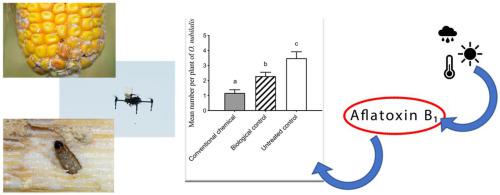Crop Protection ( IF 2.5 ) Pub Date : 2020-12-30 , DOI: 10.1016/j.cropro.2020.105529 Serena Magagnoli , Alberto Lanzoni , Antonio Masetti , Laura Depalo , Marco Albertini , Roberto Ferrari , Giorgio Spadola , Francesca Degola , Francesco M. Restivo , Giovanni Burgio

|
The European corn borer (ECB), Ostrinia nubilalis Hübner (Lepidoptera: Crambidae), is a key pest of maize (Zea mays L.). In Northern Italy, larvae of the 2nd generation may damage cobs and kernels and the feeding activity can promote the proliferation of aflatoxigenic fungi, such as Aspergillus flavus, the major producer of aflatoxin B1 (AFB1).
During 2017–2018, the efficacy of two strategies to control ECB in maize was assessed. Biological control strategy (Trichogramma brassicae Bezdenko and Bacillus thuringiensis Berliner), conventional chemical strategy (chlorantraniliprole) and an untreated control were compared to assess: i) the effect of the strategies on ECB infestation; ii) the association of ECB and AFB1 kernels contamination; iii) the impact of the strategies on beneficial arthropods.
The conventional chemical strategy demonstrated the best control of ECB infestation, followed by biological control strategy and the untreated control. No significant differences in maize yield were found among strategies. The role of ECB on AFB1 concentration was demonstrated only in 2017, when higher level of infestations occurred simultaneously with an extended period of drought and high temperatures, sanctioning the important role of meteorological conditions on AFB1 contamination.
The activity density of ground beetles, rove beetles and spiders and the mean number per leaf of the most abundant beneficial insects dwelling on plants (coccinellids, predatory thrips and lacewings) did not show significant changes between pre-and post-treatment with chlorantraniliprole, highlighting the selectivity of this pesticide in the short time.
This study provides some contribution for the reduction of non-renewable input in Italian maize fields, demonstrating that biological control strategy, although less effective than conventional chemical control, can be a feasible approach to control ECB second larval generation, without any increment of AFB1 level in grains and yield loss.
中文翻译:

在意大利北部,管理念珠菌的策略的可持续性:在不同气象条件下,对节肢动物和黄曲霉毒素污染的潜在影响
欧洲玉米bore(ECB),Ostrinia nubilalisHübner(鳞翅目:Crombidae),是玉米的主要害虫(Zea mays L.)。在意大利北部,第二代幼虫可能会损坏玉米芯和谷粒,并且摄食活动可以促进黄曲霉毒素真菌(例如黄曲霉毒素B 1(AFB 1)的主要生产者)的繁殖。
在2017-2018年期间,评估了两种控制玉米ECB的策略的有效性。比较了生物防治策略(Trichogramma braicaicae Bezdenko和苏云金芽孢杆菌Berliner ),常规化学策略(chlorantraniliprole)和未处理的对照,以评估:i)这些策略对欧洲央行侵扰的影响;ii)ECB和AFB 1籽粒污染的关联;iii)这些策略对有益节肢动物的影响。
常规化学策略显示出对ECB感染的最佳控制,其次是生物控制策略和未处理的控制。在各策略之间未发现玉米产量的显着差异。仅在2017年,欧洲央行对AFB 1浓度的作用才得到证实,当时较高水平的侵扰与干旱和高温的延长同时发生,这证明了气象条件对AFB 1污染的重要作用。
甲壳虫前处理和后处理之间,地面甲虫、,甲虫和蜘蛛的活动密度以及居住在植物上的最丰富的有益昆虫(球虫,掠食性蓟马和草lace)的平均叶数没有显示出明显变化。这种农药在短时间内的选择性。
这项研究为减少意大利玉米田的不可再生输入量做出了一些贡献,证明了生物控制策略虽然不如常规化学控制有效,但却是控制ECB第二幼虫生成的可行方法,而无需增加AFB 1谷物水平和产量损失。











































 京公网安备 11010802027423号
京公网安备 11010802027423号